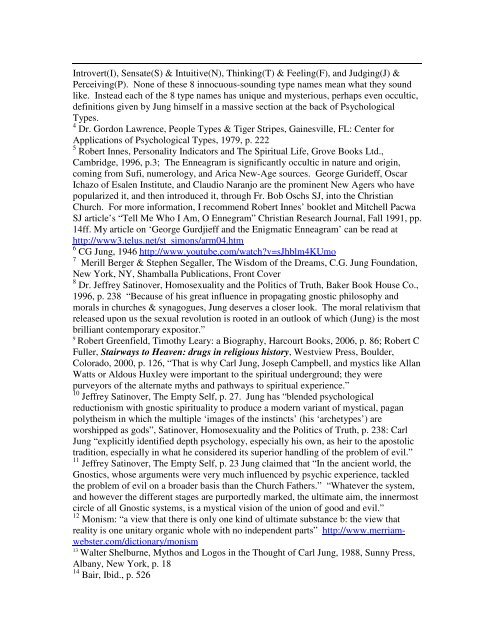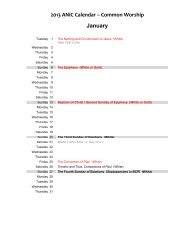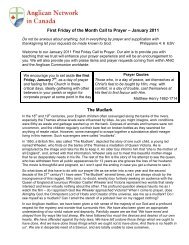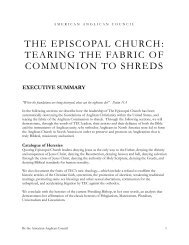Carl Jung and the Gnostic Reconciliation of Gender Opposites
Carl Jung and the Gnostic Reconciliation of Gender Opposites
Carl Jung and the Gnostic Reconciliation of Gender Opposites
Create successful ePaper yourself
Turn your PDF publications into a flip-book with our unique Google optimized e-Paper software.
Introvert(I), Sensate(S) & Intuitive(N), Thinking(T) & Feeling(F), <strong>and</strong> Judging(J) &<br />
Perceiving(P). None <strong>of</strong> <strong>the</strong>se 8 innocuous-sounding type names mean what <strong>the</strong>y sound<br />
like. Instead each <strong>of</strong> <strong>the</strong> 8 type names has unique <strong>and</strong> mysterious, perhaps even occultic,<br />
definitions given by <strong>Jung</strong> himself in a massive section at <strong>the</strong> back <strong>of</strong> Psychological<br />
Types.<br />
4 Dr. Gordon Lawrence, People Types & Tiger Stripes, Gainesville, FL: Center for<br />
Applications <strong>of</strong> Psychological Types, 1979, p. 222<br />
5 Robert Innes, Personality Indicators <strong>and</strong> The Spiritual Life, Grove Books Ltd.,<br />
Cambridge, 1996, p.3; The Enneagram is significantly occultic in nature <strong>and</strong> origin,<br />
coming from Sufi, numerology, <strong>and</strong> Arica New-Age sources. George Gurideff, Oscar<br />
Ichazo <strong>of</strong> Esalen Institute, <strong>and</strong> Claudio Naranjo are <strong>the</strong> prominent New Agers who have<br />
popularized it, <strong>and</strong> <strong>the</strong>n introduced it, through Fr. Bob Oschs SJ, into <strong>the</strong> Christian<br />
Church. For more information, I recommend Robert Innes’ booklet <strong>and</strong> Mitchell Pacwa<br />
SJ article’s “Tell Me Who I Am, O Ennegram” Christian Research Journal, Fall 1991, pp.<br />
14ff. My article on ‘George Gurdjieff <strong>and</strong> <strong>the</strong> Enigmatic Enneagram’ can be read at<br />
http://www3.telus.net/st_simons/arm04.htm<br />
6 CG <strong>Jung</strong>, 1946 http://www.youtube.com/watch?v=sJhblm4KUmo<br />
7 Merill Berger & Stephen Segaller, The Wisdom <strong>of</strong> <strong>the</strong> Dreams, C.G. <strong>Jung</strong> Foundation,<br />
New York, NY, Shamballa Publications, Front Cover<br />
8 Dr. Jeffrey Satinover, Homosexuality <strong>and</strong> <strong>the</strong> Politics <strong>of</strong> Truth, Baker Book House Co.,<br />
1996, p. 238 “Because <strong>of</strong> his great influence in propagating gnostic philosophy <strong>and</strong><br />
morals in churches & synagogues, <strong>Jung</strong> deserves a closer look. The moral relativism that<br />
released upon us <strong>the</strong> sexual revolution is rooted in an outlook <strong>of</strong> which (<strong>Jung</strong>) is <strong>the</strong> most<br />
brilliant contemporary expositor.”<br />
9<br />
Robert Greenfield, Timothy Leary: a Biography, Harcourt Books, 2006, p. 86; Robert C<br />
Fuller, Stairways to Heaven: drugs in religious history, Westview Press, Boulder,<br />
Colorado, 2000, p. 126, “That is why <strong>Carl</strong> <strong>Jung</strong>, Joseph Campbell, <strong>and</strong> mystics like Allan<br />
Watts or Aldous Huxley were important to <strong>the</strong> spiritual underground; <strong>the</strong>y were<br />
purveyors <strong>of</strong> <strong>the</strong> alternate myths <strong>and</strong> pathways to spiritual experience.”<br />
10 Jeffrey Satinover, The Empty Self, p. 27. <strong>Jung</strong> has “blended psychological<br />
reductionism with gnostic spirituality to produce a modern variant <strong>of</strong> mystical, pagan<br />
poly<strong>the</strong>ism in which <strong>the</strong> multiple ‘images <strong>of</strong> <strong>the</strong> instincts’ (his ‘archetypes’) are<br />
worshipped as gods”, Satinover, Homosexuality <strong>and</strong> <strong>the</strong> Politics <strong>of</strong> Truth, p. 238: <strong>Carl</strong><br />
<strong>Jung</strong> “explicitly identified depth psychology, especially his own, as heir to <strong>the</strong> apostolic<br />
tradition, especially in what he considered its superior h<strong>and</strong>ling <strong>of</strong> <strong>the</strong> problem <strong>of</strong> evil.”<br />
11 Jeffrey Satinover, The Empty Self, p. 23 <strong>Jung</strong> claimed that “In <strong>the</strong> ancient world, <strong>the</strong><br />
<strong>Gnostic</strong>s, whose arguments were very much influenced by psychic experience, tackled<br />
<strong>the</strong> problem <strong>of</strong> evil on a broader basis than <strong>the</strong> Church Fa<strong>the</strong>rs.” “Whatever <strong>the</strong> system,<br />
<strong>and</strong> however <strong>the</strong> different stages are purportedly marked, <strong>the</strong> ultimate aim, <strong>the</strong> innermost<br />
circle <strong>of</strong> all <strong>Gnostic</strong> systems, is a mystical vision <strong>of</strong> <strong>the</strong> union <strong>of</strong> good <strong>and</strong> evil.”<br />
12 Monism: “a view that <strong>the</strong>re is only one kind <strong>of</strong> ultimate substance b: <strong>the</strong> view that<br />
reality is one unitary organic whole with no independent parts” http://www.merriamwebster.com/dictionary/monism<br />
13<br />
Walter Shelburne, Mythos <strong>and</strong> Logos in <strong>the</strong> Thought <strong>of</strong> <strong>Carl</strong> <strong>Jung</strong>, 1988, Sunny Press,<br />
Albany, New York, p. 18<br />
14 Bair, Ibid., p. 526









